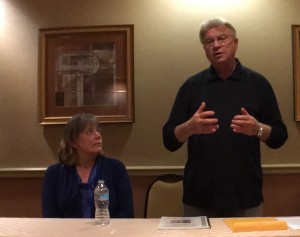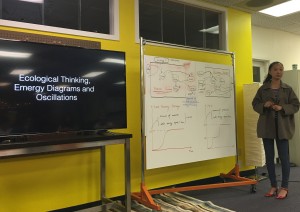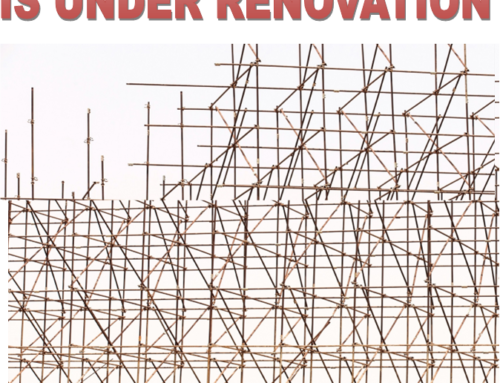Mid-February 2016, representatives from Technocracy Inc. attended a Think Tank presentation about sustainability, economics, and the futures of both. Mark Ciotola, physicist and professor, whom you know from our website articles and Facebook discussions, and Jiarong Dong, chemical engineer & entropy activist provided an excellent presentation on Sustainability.
First came a simple, yet complex question – What is Sustainability?
As a graceful tandem team Mark and Jiarong went on to explain the question and provide answers.
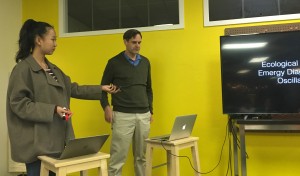
There was so much to absorb that I will give a very brief summary that names the ideas but doesn’t expound on them. I will leave the explaining for the scientists.
The 2 pillars of viewpoint – Outer and Inner
Outer – Big Bang, Thermodynamic Potential, and more – were explained clearly with graphics that made sense, even to those attending with no education in physics, chemistry, or economics.
Inner – Systems Dynamic Approach, Agent Based Systems, Cradle2Cradle – These were some of the areas that were discussed with very fascinating points, that had me so interested I forgot to take notes!
The gist of this section as I understood it was as follows:
We cannot eliminate the difference in individuals (communities, geography, people, etc.) and must consider the whole. Sometimes when viewing parts as the whole, a solution seems obvious, but when you inspect all the individual parts, the “obvious” solution will not work. And you must look at the individual parts and then put that specific information into the whole view to provide a solution that will actually be workable.
Entropy can be used as a currency in Sustainability Accounting? (Entropy accounting is highly related to the energy accounting proposed by Technocracy.)
My internal question was; ”What is Entropy?” This concept was discussed at length, both during the presentation and after in the animated discussions of the presentation by the varied and amazing audience.
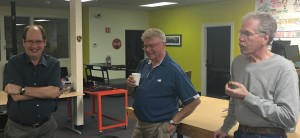
Below is a definition from the internet (this was not in the presentation, but as I cannot remember the exact terms from the presentation, this will do):
Entropy is a measure of the amount of energy in a physical system not available to do work. As a physical system becomes more disordered, and its energy becomes more evenly distributed, that energy becomes less able to do work. For example, a car rolling along a road has kinetic energy that could do work (by carrying or colliding with something); as friction slows it down and its energy is distributed to its surroundings as heat, it loses this ability. The amount of entropy is often thought of as the amount of disorder in a system.
There was so much to take in – Systems Dynamic Approach, Agent Based Systems, Free Markets, Sustainability Accounting, Cradle to Cradle design (Put simply, Cradle to Cradle is a holistic economic, industrial and social framework that seeks to create systems that are not only efficient but also essentially waste free).
There was much discussed regarding the Environment, Sustainability and keeping ourselves and our “spaceship” Earth alive and functioning well! Many groups focus on the distant future or abstract visions. This group was focused on the actual how to get where we want to be from where we are, the concrete steps instead of focusing only on where we want to be. Where we want to be is of course a necessary and guiding force, but if we don’t have the steps to take, we get nowhere.
Another focus of this group is one that isn’t often taken into account but is vital because any plan will fail if it is not taken into account, and that is – “How does/or how will this plan affect society in general, and those individuals within society? Will this plan succeed and will society and individuals be able to embrace it and feel invested in the approach?”
Social constraints used to function on a small scale within one’s own community which set the values and mores that were comfortable for that community; now, with social media playing a major part in many lives, this small scale leapt exponentially to be viewed and operated on a large scale. Someone in Alabama can comment on and possibly ‘judge’ (to use an inflammatory word) a person in New Zealand’s post. These comments may have a strong effect on many people. And the person commenting doesn’t always think about the differing community values, mores, and customs; they ‘judge’ by their own community’s values. This phenomenon is changing the world. It is pertinent to be aware of how these social constraints are evolving.
Much of the presentation focused on “Dynamic Equilibrium.” This is a common term in chemistry, but in this presentation was applied to the social design and/or our economies. Stability is a result of reaching a Dynamic Equilibrium, not a stasis or static environment, but a stability where there is still movement, growth and change without the large hills and valleys that currently happen.
From my understanding, if we have a Dynamic Equilibrium in the whole, there would still be flexibility for each individual community to change as needed within the guidelines of the whole. To attain this, we must watch the changes, pay attention to the feedback received and make adjustments for progression.
This presentation left me feeling excited about the future. People are interested in and very concerned about the future. Most want collaborative experiences.
We are not damned to doom and gloom and a Zombie Apocalypse! As a whole, we can make excellent sustainable choices with individual freedom and a view toward global sustainability.
Mark Ciotola and participants gave an excellent presentation and clearly put much work into doing so. Mark is also editing Trend Events while doing his full time job. We are impressed and so thankful to you, Jiarong, and all of the participants.
In addition, George Wright gave an interesting and animated talk about Technocracy.
